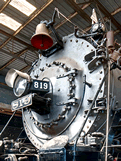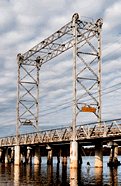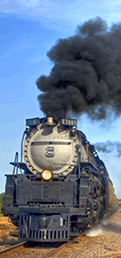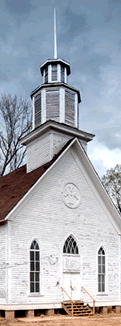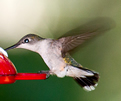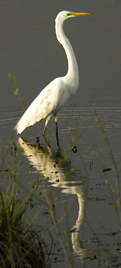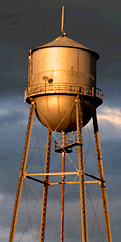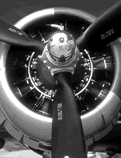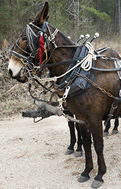|
|
|
|
 |
|
|
|

The old Missouri-Pacific Railroad Bridge near Yancopin, Arkansas, appears to have a lift span . . . and a turn span. The 73-mile-long section of railroad in which the 107-year-old structure resides was removed from service in 1992 and was eventually turned over to the Arkansas Department of Parks and Tourism. 
Sunday, October 17, 2010 This bridge, northeast of Yancopin, Arkansas, which is northeast of Watson, was a part of the Missouri-Pacific Railroad system. It was completed and put in service in 1903, according to the best sources I can find. A steady stream of rail traffic moved across the bridge until 1992, when railroad management decided to take that section of their system out of service. One railroader who plied the tracks on a regular basis for many years said that the subject stretch of rail was one the best. "It was rated for 60 miles an hour," he said. Eventually, these 73 miles of railroad were handed over to the Arkansas Department of Parks and Tourism, lock, stock, and bridge. Subsequently, department officials named the section the "Delta Heritage Trail." Some work has been done on the trail, which is now negotiable southeast from Helena, Arkansas, for four miles by foot or bicycle. The rest of the trail, we are told, is under development. When and if it is completed, the Delta Heritage Trail will afford the hikers and bikers who traverse it a unique view of the deep innards of Delta wilderness, plus an up-close-and-personal look at some serious agricultural ventures.  If you travel northeast on the levee road from Yancopin, the bridge is easy to find. You will eventually drive under it. Here the east approach structure seems to be in good condition. Even this far back in the boondocks, the graffiti artists attack. Perhaps in the next millennium, social scientists and art eggheads will ponder the deeper meaning of the Krylon movement. Though I can find no one to confirm it, my eyes see a turning mechanism for a rotating span atop the third support from the right (the east side of the river) — and the counter-weights and towers associated with a lift span between the first and second supports from the right. I have heard reports of the center span turning, but in all honesty, have heard no reports of the east span lifting. Still, the counter-weights and tower are in plain view.  Perched atop the east span is the control house for the alleged lifting mechanism. Note, no elevator. No air conditioning, either. Hotter than the hubs of Hades in the summer and colder than a well-digger’s butt in the Klondike during winter months. Those with vertigo need not apply. See the control house for the turn span, similarly lacking in amenities, at our Weekly Grist for the Eyes and Mind link at the bottom of this page.  By now, you are asking where in the #$@#!!! did the name "Yancopin" come from? First the pronunciation. Do not pronounce it as you read it unless you want to reveal the fact that you are a stranger. It is properly pronounced "yonk-ah-pen," or as an alternative, "yonky-pen." There are two opposing theories on the name. The first: Legend has it that during the War Between the States, the Union Army had a small POW camp in the area, thus "Yankee pen," which over the years transmogrified to Yancopin. The second, similarly lacking in scientific basis, but not nearly as colorful, is that Indians, the original inhabitants, named the area after an indigenous plant. Take your choice. Or make up your own, which may fly better than these two.
Sat 02/12/2011 12:31 A little info: Quoted from the article: "Though I can find no one to confirm it, my eyes see a turning mechanism for a rotating span atop the third support from the right (the east side of the river) — and the counter-weights and towers associated with a lift span between the first and second supports from the right. I have heard reports of the center span turning, but in all honesty, have heard no reports of the east span lifting." I have breakfast with a friend who is involved with the seasonal opening of the Yancopin railroad bridge to allow loggers to transport logs down river. He was telling me they go down and rotate the span open. Then return to close the span months later. Here are some pics I got off line from a posting from one of the men in the crew from the Arkansas Highway & Transportation Dept. responsible for the operation of the bridge:
Later,
N O T E S:
Most of the time, there is more to the Photo of the Week story than can be told in an essay. And most of the time there are more pictures to be seen. Presuming that some folk will enjoy being privy to this trove of information, I have created a blog, “Weekly Grist for the Eyes and Mind,” where I am showing and telling “the rest of the story." There are also some blatantly commercial mentions of some of the things we do to earn our beans and taters. Click on the Weekly Grist logo and go to the blog. — J. D.
 |
|
|
|
|
|

|
|
|
|
CornDancer.com is the personal website of Dr. Freddie A. Bowles and Ebenezer Baldwin Bowles.
CornDancer has participated in the World Wide Web since 2000. Submissions are invited. Contact webmaster at threadspinner@corndancer.com |
|
|
|





